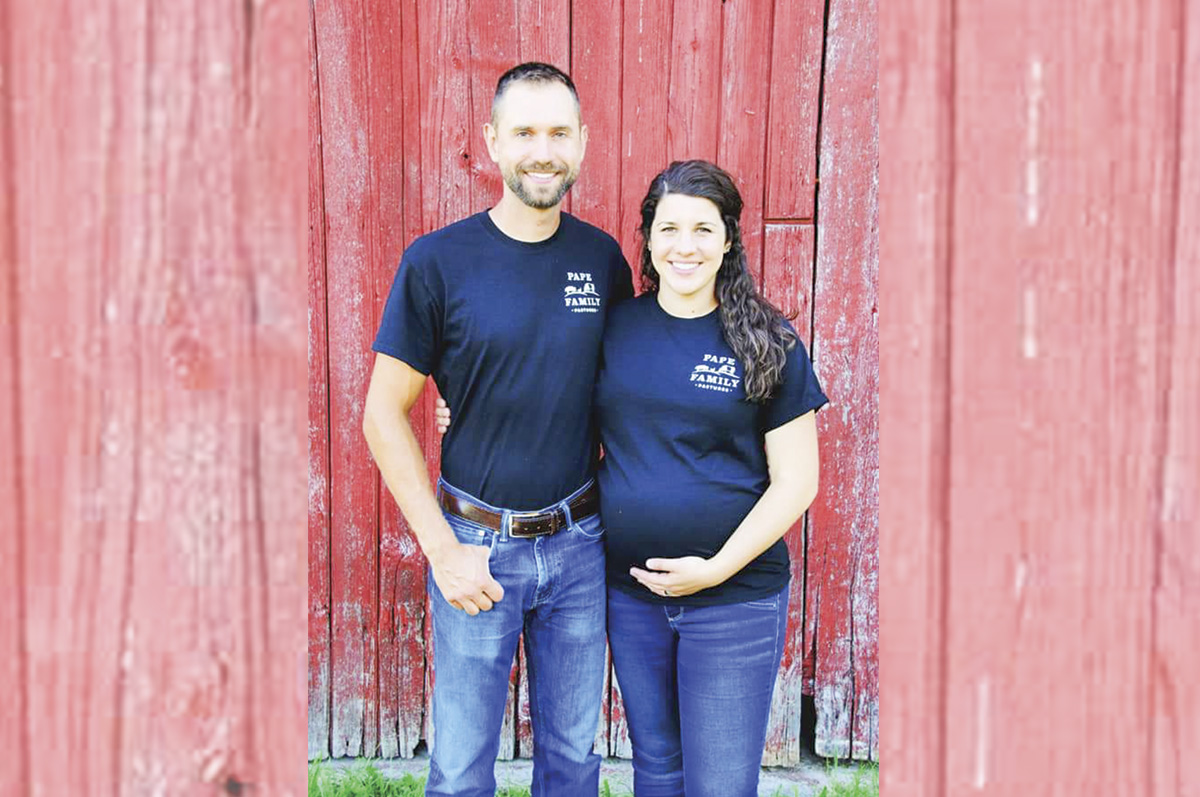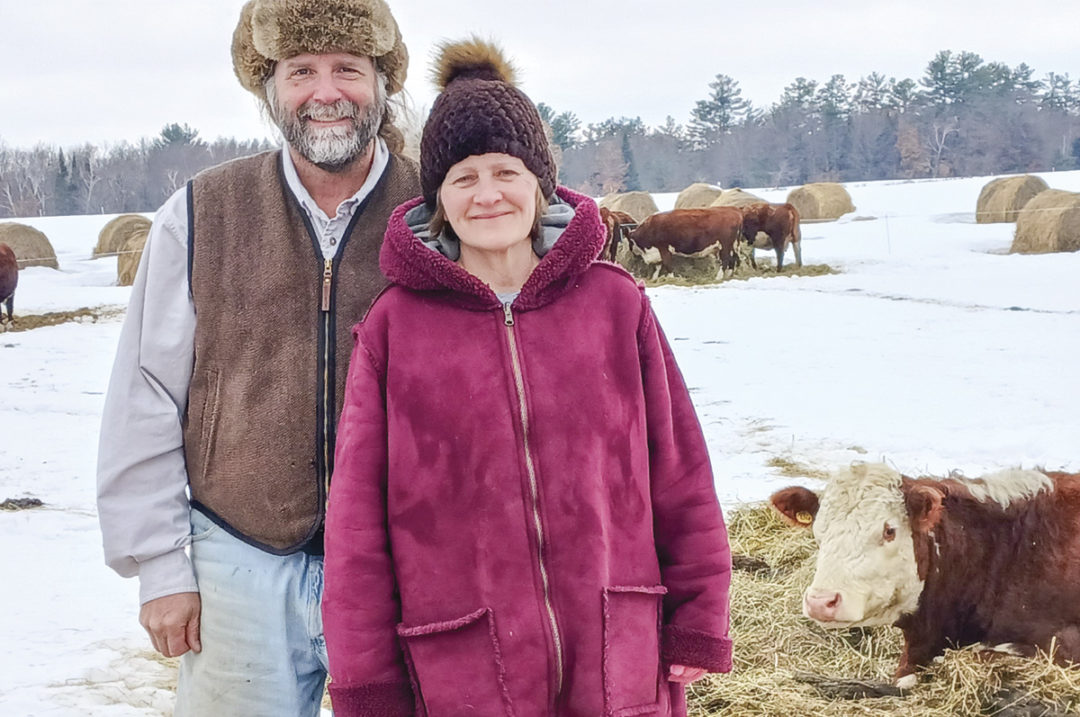Good pasture management requires a whole lot more than just putting animals out on a paddock. Dale Goss of Bruce, Wisconsin, and Aaron Pape of Peshtigo, Wisconsin, shared some of the lessons they learned about beginning grazing at the GrassWorks Grazing Conference, held annually in Wisconsin.
The Gosses established Bull Moose Lake Farm in 2017. They raise grass-fed beef, along with pasture-raised poultry and pork. They grow their own sprouts to feed in the winter and outwinter their animals. They plan for spring calving in early May, so the calves are ready to graze when the grass greens up.
Goss says observing the animals, plants and soil is essential to setting up a good grazing system. “Daily paddock moves are a great way to improve observation. What are the animals eating? How fast is the forage growing? Is there fly pressure? Are drought conditions building? What beneficial insects are in the pasture?”
Seeding is expensive, he says, so it’s important to figure out what works well on your operation. Goss has been able to successfully use an old Van Brunt B John Deere drill to practice no-till drill seeding; although he says the conditions must be just right. Frost seeding has had varying results with multiple species. Seed-to-soil contact is necessary for good germination, so use a cultipacker when broadcasting seed. Smaller seeds work best when frost seeding. He thought mature perennial grasses would do a good job of reseeding but observed they actually self-seed less than 25%.
For new farmers, he also recommends drilling in seed with a crisscross pattern instead of one direction. He says, “Tips like these aren't obvious to beginning farmers who have limited agricultural experience.”
Poly tape is safer than poly wire if something happens and an animal gets caught in it. For his operation, he's moving to poly tape that has a lower breaking point, so if the paddock tape breaks, the animals are still contained within a five-wire electric perimeter fence.
In 2021-22, very dry drought conditions moved into the area, and Goss says it's best to have your drought plan ready. “Last year we practiced ‘speed grazing,’” he says. “We moved the animals through paddocks faster than usual and left a higher residual. This places less stress on the plant and helps keep the ground cooler where the critical microbiology lives.” Also, they fed bales much earlier than planned by placing them in the paddock where the grass was thin or the soil needed more nutrients. This winter they set up for paddock bale grazing; primarily to improve the soil.
Goss recommends attending pasture walks in your area to see different systems and to learn from other graziers about what works and what doesn’t. He says they’ve learned about multispecies and herd grazing, the use of warm-season annual grasses and cool-season perennials, the importance of including legumes and forbs in grass pastures and visited successful grass-fed dairy operations no longer using commercial fertilizer inputs. A handy tip – use collapsible garden water hoses for winter stock tank filling on cold winter days.
The Gosses sell directly to consumers, and he says it takes time and effort to understand labeling requirements. “We wanted ‘Pastured Pork’ on our label and instead got ‘Never Confined to a Feed Lot.’”
“As a producer, understand labeling ‘claim’ requirements before making your requests,” Goss says. Each state has its own laws and regulations.
“You can’t just show up with frozen meat and sell at a farmers market, or advertise online for shipping and delivering,” he says. Licensing is required.
Goss says if you are going to direct market at a farmers' market, accepting electronic payments is important. He also advises having a 10-15 second “spiel” about why people should buy your product and what makes it special, offering products in a range of prices and seeking cooperation with other vendors – rather than seeing them as competition.
When you obtain animals you plan to market, lock in the dates with your processor; don’t wait until the animals are close to finishing and think your locker plant will have availability. They are now booking two years in advance.
In closing, he says “What works on one farm may not work on another – find what works for you and your farm, observe and listen to your soil, animals [and] customers, and work with your local grazing network, NRCS and county conservationists.”
 Aaron and his wife, Erin, raise grass-fed beef, pastured pigs and pastured chickens and have outwintered their animals for the past six years. Photo provided by Kelli Boylen.
Aaron and his wife, Erin, raise grass-fed beef, pastured pigs and pastured chickens and have outwintered their animals for the past six years. Photo provided by Kelli Boylen.
Another perspective
Aaron Pape, a grazier and farm business instructor for Northeast Wisconsin Technical College, says cash flow planning is the most powerful tool he uses. “It makes you think through your entire production cycle. It helps you anticipate cash shortfalls and plan for profits. If you want an actual business and not just an expensive hobby, this is how you do it.”
He recommends contacting a farm business instructor at your local technical college for training and assistance in cash flow planning.
Aaron and his wife, Erin, raise grass-fed beef, pastured pigs and pastured chickens and have outwintered their animals for the past six years. They are self-described “fervent conservationists” and “passionate grazing advocates.”
Planning ahead for just about everything is the other advice Pape recommends. "Think through how you are going to move animals, including how you are going to move vehicles in and out, before creating your setup."
Even if you aren’t going to direct market your animals, Pape says you still need to plan ahead. "Talk to your county health department to make sure you know the regulations." He advises calling sale barns to learn about cattle auctions and learn how to get the most money for animals long before they are ready for market.
If you're interested in direct marketing beef, Aaron recommends purchasing a complete herd of calves, yearlings and cows so you don’t have to start completely over once your first batch of animals is sold.
Plan your electric fences in a way that allows for underfence mowing. “You can never have too many gates or too wide of gates. When near buildings, try to have the gates open toward your buildings whenever possible.” Pape also recommends using rope gates whenever possible.
When planting pastures, think about what purpose each species you plant will serve. "Diversity for diversity's sake isn’t always practical," he says. "For example, cattle won’t eat chicory, and orchardgrass will often take over a mix as time passes."
And as far as deciding when to move your cattle to another paddock, Pape says, “If you think they might need another hour, just move them now. You will end up with faster regrowth.”
If you decide to sync your herd for breeding purposes, talk to your A.I. tech first to set the date before dosing your cattle. A.I. techs can be hard to find, and it may be necessary to have your own nitrogen tank to store semen. Pape rents a bull to run with his herd. He says it simply isn’t cost efficient to own a bull with a small number of cows.










